
Electrostatics (A-level physics)

Electrostatics
This is the study of electrical charges at rest.
There are two kinds of charges i.e., unlike charges which attract and like charges which repel.
Positive and negative charges
Glass rubbed with silk develops a positive charge whereas an rubber rubbed with fur develops a negative charge. This is because during rubbing electrons move from glass to silk whence the glass become positively charged whereas silk becomes negatively charged.
Similarly, electrons move from fur to rubber during rubbing and rubber becomes negatively charged while fur becomes positively charged.
Insulators and conductors
In insulators, electrons in the atoms are firmly bound to the nucleus and the removal or addition of electrons at a place does not cause flow of electrons elsewhere.
In conductors, the electrons are free to move from individual atoms and if such materials gain electrons these can move about in them. The loss of electrons by conductors cause a redistribution of those left. A charge on the conduct therefore spreads over entire surface.
Examples of insulators include glass, rubber and plastics.
Examples of conductors include metals, water, and electrolytic solutions
Charging insulators by contact rubbing or friction
Insulators can only be charged by contact rubbing or friction. Consider two bodies A and B of different work functions.
NB. Work function is the minimum energy required by an electron to escape from the surface of an atom.
When a body A has a low work function compared to B, then, during rubbing, body A will lose electron to body B due to heat energy that increases the kinetic energy of electrons.
Body A becomes positively charged while body B becomes negatively charged.
Example 1
Explain how charging by rubbing occurs.
Electrostatic induction
This is the process by which a neutral body places near a charged body gets charged with contact.
Induction is used when charging conductors where induced charges are obtained without contact with other charges.
Consider two insulated metal spheres A and B, arranged such that they touch one another. A negatively charged rod C is brought near A.

While keeping the inducing rod C in position, the spheres are separated and tested with a charged pith ball. It is discovered that A has a positive charged and B has a negative charge.

If the spheres are brought back in contact, it is found that they have no effect on the pith ball. Their charges have neutralized each other. This shows that
(i) positive and negative charges are created.
(ii) the number of electrons which move is equal to the number of positive charges that are created.
- Charging by induction
(a) Charging a conductor negatively by induction.

b) Charging a conductor positively by induction

Gold leaf electroscope
This is an instrument for testing the presence, the sign and the magnitude of the charge.
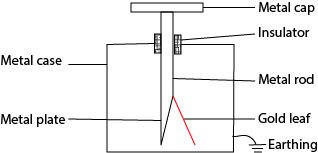
It consists of a circular metal disc (cap) attached to a metal rod with a brass plate to which is attached a thin foil of gold or aluminium.
It is fitted in a metal case with help of a plug (insulator) using perspex windows. The metal case is earthed in order to screen the electroscope from outside influences other than those brought nearer the cap and it is insulated from the ground.
Mode of action
When a charged body id brought near or in contact with the cap of the electroscope, the cap will acquire an opposite charge by induction. The charge on the body will repel all charges similar to it down to the rod, to the plate and the leaf.
Due to presence of like charges on the plate and gold leaf, the leaf diverges as it is repelled by the plate.
Leaf divergence indicates that the body brought nearer or in contact with the cap carries a charge.
Uses of the gold leaf electroscope
- Detecting of charge on a body
- Testing the nature and sign of charge on the body
- Comparing the magnitude of charge on various bodies
- Test the insulating and conducting properties of various substances
- Measure potential difference
- Testing for the nature or sign of charge
Charge a gold electroscope (GLE) negatively. Bring the body under test near the cap of GLE, it the leaf diverges further, then the body has a negative charge but if the gold leaf collapses, then that body is either has a positive or a neutral conductor.
The experiment is repeated is repeated where the GLE is charged is charged positively.
A charged body is brought near the cap; if the gold leaf diverges more, the body is positively charged. If the gold leaf collapses, the charged body is either negatively charged or neutral conductor.
Note that an increase in divergence occurs when the charge on electroscope and the tested charge are the same. Therefore, an increase in divergence is the only sure test for a sign of charge on the body.
- To detect the presence of a charge on a body
Bring the b0dy to be tested near the metal cap of a neutral gold leaf electroscope. When the leaf deflected, then the body has got a charge. However, it the leaf remain undeflected, then a charge is absent on the body.
- To compare and measure potentials
Two bodies which are similarly charged are brought into contact with the metal cap of the gold electroscope one after another. The body that cause a big divergence has a big charge.
- To classify conductors and insulators
Bring the body to be tested in contact with the metal cap of a charged gold leaf electroscope. When the leaf collapses suddenly, then the body is a good conductor. If it collapses gradually, the body is a bad conductor. However, if it does not collapse then, it is an insulator.
Example 2
Describe how a gold leaf can be charged positively and negatively by induction.
(a) Charging gold leaf electroscope positively by induction
Procedures
- A negatively charged rod is brought a cap of GLE
- The cap is earthed while the charged body is still in place.
- Earth connection is removed.
- Lastly the charged body is removed.

Observation/explanation
- When a negatively charged body is brought near a cap of GLE, positive charges are induced on the cap while electrons are repelled to the metal plate and the gold leaf. The gold leaf is repelled and diverges.
- When the cap is earthed say by touching it with a finger, electrons flow to the earth and the leaf collapses.
- When the earth connection is removed, the remaining positive charge on the cap redistributes itself on the Gold leaf and the leaf diverges again.
- When the charged body is removed, the GLE acquires a permanent positive charge.
(b) Charging gold leaf electroscope negatively by induction
Procedures
- A Positively charged rod is brought a cap of GLE
- The cap is earthed while the charged body is still in place.
- The earth connection is removed.
- Lastly the charged body is removed.
Observation/explanation

- When a positively charged body is brought near a cap of GLE, positive charges are induced on the cap while electrons are repelled to the metal plate and the gold leaf. The gold leaf is repelled and diverges.
- When the cap is earthed say by touching it with a finger, electrons flow from the earth and the leaf collapses.
- When the earth connection is removed, the acquired negative charge on the cap redistributes itself on the Gold leaf and the leaf diverges again.
- When the charged body is removed, the GLE acquires a permanent negative charge.
Electrophorus
This a device which provides large quantities of charge by induction. It consists of an insulator (e.g. polyethylene) and a metal disc with an insulated metal handle.

Procedure
The polyethene is charged negatively by rubbing it vigorously with a duster, when the metal disc is laid up on it. It acquires induced positive charge after earthing it with a finger. Very little negative charge from the polyethene to disc because the material has uneven surface preventing them from touching at more than a few point. Little charge escapes from these points only because the polyethene is a nonconductor. On removing the disc, it has a sufficient positive charge.
The disc can be discharged and charged again until the charge on the polyethene has disappeared by linkage.
Electrophorus is a device used for converting mechanical energy into electrical energy. Since work is done in raising the disc against the attraction of the opposite charge.
Electrophorus and the advantage of charging by induction
- Supply of charge is almost unlimited because the origin of charge in not carried away.
- A greater charge nearly equal to that of the whole of polyethene can be concentrated on the conducting disc.
- Only a very small charge can be transferred by contact leakage because the polyethene is not a conductor.
- The disc can be discharged and recharged.
Charge distribution
Surface density is a charge per unit area in a conductor’s surface. Surface density increases with the curvature of the body. The charge density is higher on the pointed and sharp surfaces than on round ones.
Testing charge distribution using proof planes
A proof plane consists of an aluminium foil (leaf) which can be modeled to fit any shape. It is made from a small sheets of the different shapes but to the same size.
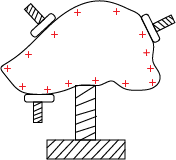
When a proof plane is placed at any point when contact with any surface, it carries away the charge which is directly proportional to the charge per unit area of the body at this point.
This charge is tested by lowering the proof plane in the can connected to an electrophorus. Different shapes of the conductors are investigated, it found that the charge per unit area or surface density increases with the curvature of the body, i.e. the leaf divergence is directly proportional to the charge density at the point of the body.
Faraday’s ice pail experiments
The ice pail is placed on an insulator and connected to a gold leaf electroscope
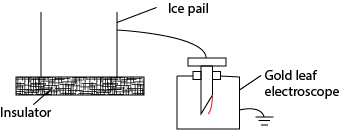
A metal ball held on a long silk thread is charged positively and then lowered into the pail without allowing it to touch the pail side or the bottom of the pail. The positive charge is induced on the outside of the pail and the leaf diverges
Once the ball is inside the pail, the divergence of the leaf does not change when the ball is moved around, near to or further from the bottom of the pail which shows that the amount of induced positive charge does not the position of the ball once it is in the pail

The metal ball is allowed to touch the pail and no leaf divergence is observed. This means that when the ball touches the pail no charge is given to or taken away from outside of the pail.
The metal ball is then removed and tested for the charge with gold leaf electroscope. It was found that the ball had no charge, hence, the induced charge on the inside of the pail must have been equal in magnitude to the original positive charge on the ball
These conclusion apply only to hollow closed conductors
- When a charged body is enclosed in a hollow conductor, it induces on the inside of a conductor a charge equal and opposite its own and on outside a charge equal and similar to its own
- The total charge inside the conductor is always zero, either there is equal and opposite charges on the inside (before the ball touches) or there is zero no charge at all after the ball has touched.
Example 3
A charged body of 10C is lowered in a charged ice pail which carries a charge of -3C in the inside and +5C on the outside. Find the total charge on the pail when
(i) The ball is lowered without touching
(ii) The ball is allowed to touch the bottom of the pail.
Solution
(i) Without touching the pail
Outside = +10C + 5C = +15C
Inside = -10C – 3C = -13C
(ii) When the ball touches the bottom
Inside = -13C + 10C = -3C
Outside = +15C – 3C = +12C
Corona Discharge

Consider a positively charged conductor placed in air. Due to the high concentration at the pointed end, the electric filed intensity is very high which causes the ionization of air nearer the sharp end of the conductor.
The negative charges are attracted to the conductor while the positive charges are repelled. The negative charges partially neutralize the positive charges causing the conductor to lose some charges. The apparent loss of charge is called Corona discharge.
Definition of corona discharge
Corona discharge is the apparent loss of charge by sharp conductors due to ionization of air molecules around by the high charge intensities applied at the pointed ends which break the ionization of air.
Example 4
Explain what is meant by Action at points in electrostatics (Corona discharge)
Application of corona discharge
- The lightning conductor.
Lightning forms when the electrons in the bottom of a cloud are attracted to the protons in the ground. When the attraction of these electrical charges is greater than the surrounding air’s resistance to electrical flow, the electrons are able to stream down to the protons If the strike contacts a material that is not a good conductor, the material will suffer massive heat damage.
Lightning conductor is a conducting rod with sharp spikes erected at the topmost region of a building to be protected. The rod is connected to earth via thick copper strips. The contact with earth is kept well conducting.
If lightning hits the structure, it will preferentially strike the rod and the enormous electrical current associated with the strike is conducted to ground through a copper strip, instead of passing through the structure, where it could start a fire or cause electrocution.
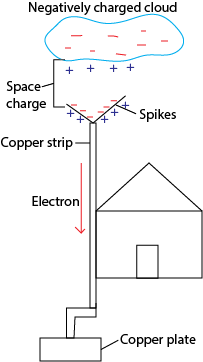
Action
(i) When a negatively charged cloud passes over lightning conductor, it induces positive charges on the spikes and repel electrons on the grounds through copper conductor.
(ii) A high electric field concentration of positive ions on the spikes ionizes air around it causing positively charged ions and negatively ions.
(iii) The negatively charged ions are attracted and discharged at the spikes while the positively charged ions are repelled to form a space charges which neutralizes the negative charge on the cloud. In this way the harmful effect of the cloud is reduced.
Example 5
Explain how a lightening conductor works.
How lightening conductor causes damaging to buildings and trees.
In discharging the earth, lightening tends to strike the highest points such as the smallest trees among the trees and buildings. Thunder clouds contains large quantities of negative charges on their underside and positive charges on their tops. When a negatively charged clouds gather over a building, it induces a large positive charge on the roof resulting in a very high potential difference between the cloud and the building.
The force of attraction between the positive charge and the negative charge can be so strong that the electron suddenly jump from the cloud to the roof producing a flash of lightening.
In the flash without a lightening conductor this current passes through a much higher resistance producing a great deal of heat. The heat vaporizes the moisture in the structure explosively and causes a great structural damage or sometimes sets the building on fire.
- Van der Graff generator
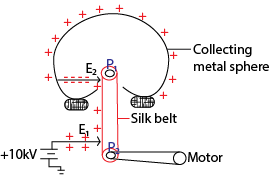
Main features
- It consists of a large hollow metal sphere (collecting sphere) supported on insulating stand.
- A silk belt inside the tube driven by an electric motor possesses the sharply pointed electrode metal E1, held at electric potential of about 10kV relative to the earth.
- As the belt moves up, it passes another sharply pointed metal electrode E2 connected inside the hollow sphere.
Mode of operation of Van der Graff generator
(i) The metal rod E1, is kept at a high positive potential of about 10kV with respect to the earth.
(ii) The high positive charge at the sharp ends ionizes the air around.
(iii) The positive ions are repelled to the silk belt carries then towards the collecting sphere.
(iv) At E2, the silk belt induces negative charges on the sharp ends of E1 and the positive charges on the outer of the sphere. The electric field at point ends E2 ionizes the air around it.
(v) The negatively charged ions are repelled to the silk belt which is carrying positively charged ions
(v) The positive ions are neutralized before passing over the upper pulley P1.
(vi) The process of silk belt charging up and dis charging is repeated many times per second and each time the belt passes, the sphere charges up positively until it has electric it has electric potential of about 106V relative to the earth.
Example 6
Describe with aid of a diagram the mode of operation of a van der Graff generator.
Or
Describe the application of Corona discharge in Van der Graff generator.
Or
Describe the applications of electrostatics
Example 7
The belt of a van der Graff generator is of width 20 cm and travels at a speed of 15ms-1. The charge density is 1.5 x 10-4Cm-2. The generator is connected to a resistor of 6.0 x 109Ω.
Determine
(i) The maximum current that can be drawn from the generator
(ii) Maximum possible power output of the motor that drives the belt.
(iii) Maximum potential difference
Solution
(i) Area per second = speed x width
![]()
Charge carried per second = charge density x width
= 1.5 x 10-4 x 3
= 4.5 x 10-4Cs-1
But rate of flow charge is current
Maximum stead current, Imax = 4.5 x 10-4Cs-1
= 4.5 x 10-4A
(ii) From ohm’s law
Vmax = Imax x R
= 4.5 x 10-4 x 6.0 x 109
= 2.7 x 106V
![]()
Example 8.
A large van der Graff generator has a top terminal in the form of a sphere of diameter 3.5m. When the terminal is at the operating potential of 3.5 x 106V, what is
(i) The stored charge
(ii) The energy stored
(iii) The electric field intensity of the surface of the sphere.
Solution

Consider two electrically charged bodies at a separation r which is much larger than the dimension of the bodies. The bodies at such a separation behave like point charges.
- The electrostatic force, F, between two pints charges Q1 and Q2 is directly proportional to the product of the magnitude of the charge.
![]()
- It is inversely proportional to the square of the distance between the two equation

Where k is a constant of proportionality

Coulomb’s Law
The force between any two point charges is directly proportional to the magnitude of the product of the charges and inversely proportional to the square of the distance between them.
Example 9
Calculate the value of two equal charges if they repel each other with a force of 0.1N when placed 50cm apart in the vacuum. What would be the size of the charge if they were situated in an insulating liquid whose permittivity was ten times that of the vacuum?

= 5.27 x 10-6C
Relative permittivity εr
is the ratio of the permittivity of any medium to the permittivity of free space
Subunits
10-3 – mill (m)
10-6 – micro(μ)
10-9 – nano (n)
10-12 – pico (p)
103 – kilo (k)
106 – Mega (M)
109 – Giga (G)
Example 10
Find the force between two point charges of +4μC and -3μC placed at a distance of 10cm apart in air.

Example 11
Four charges are placed at the corner of a square ABCD as shown below.
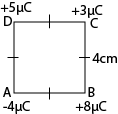
Find the resultant force on the charge at C
Solution
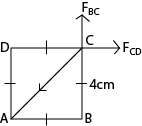

Distance AC
(AC)2 = (AB)2 + (BC)2


Resolving vertically
Fy = 135 – 33.75sin45 = 111.135N
Resolving horizontally
Fx = 84.375 – 33.75cos 45 = 60.51N

= 111.1352 + 60.512
R = 126.52N

θ = 61.40
Hence the resultant force at C = 126.54N at 61.40 to the horizontal
Example 12
Find the resultant force at A

Solution
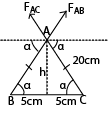
h2+ 52 = 202
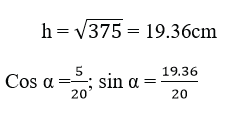
Force on A due to charge at B

Force on A due to charge at C


Resolving vertically
Fy = 1.35sinα + 3.375sin α
![]()
Resolving horizontally
Fx = 1.35cosα + 3.375cos α
![]()
R2 = 0.506252 + 4.5752
R = 4.603N

θ = 83.70
Hence the resultant force at C is 4.603N at 83.70 to the horizontal
Example 13
Find the force at O

Solution



![]()
Resolving vertically;
Fy = 72sinθ + 43.2sinθ -144sinθ-144sinθ
= 172.8 sinθ
= 172.8 x 0.8
= 138.24N
Fx = 43.2cosθ + 144cosθ – 144cosθ – 72cosθ
= -28.8cosθ
= -28.8 x 0.6
= -17.2N

R2 = =17.282 + 138.242
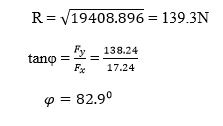
Hence the resultant force at O is 139.3N at 82.90 to horizontal
Example 14
Find the resultant force on B




Resolving vertically
Fy = -12.5 – 9 x 0.7 = 17.9N
Fx= 21.09 – 9 x 0.8 = 13.89N

R2 = 13.892 + 17.92
R = = 22.7N
![]()
θ = 52.10
The resultant force at C is 22.7N at 52.10 to the horizontal
Example 15
Find the resultant force on B

Solution


Resultant force, R = 28.125 – 21.875 = 6.25N towards A
Sponsored by The Science Foundation College + 256 753 801709
Compiled by Dr. Bbosa Science

The services are super and l appreciate them.
I have benefited much. Thanks
HOW CAN I DOWNLOAD THE NOTES?
When using a phone go to digitalteachers.co.ug website then tap on the three horizontal line on the the top left corner and follow the prompts.
I thank for this work it has helped me
U guys are great I think students must try out
How can I download
How can I download the notes
Go to digitalteachers.co.ug website, tap the three horizontal lines on the top left, then science subjects, physics, A-level physic and click a topic of your choice to download
Your writing was remarkably illuminating! The breadth of information and the captivating delivery mesmerized me The depth of research and mastery evident throughout significantly heightens the content’s excellence The insights in the introductory and concluding parts were especially thought-provoking, sparking fresh concepts and inquiries that I hope you’ll explore in future writings If there are additional resources for further exploration on this subject, I’d be eager to delve into them Thank you for sharing your expertise and enhancing our understanding of this topic The exceptional quality of this piece compelled me to comment immediately after reading Continue the fantastic work—I’ll certainly return for more updates Your dedication to crafting such an outstanding article is highly valued!
thankyou for your service bambi the notes are good and easy to read as well as summarized
Electrostatics (A-level physics) – Digital Teachers Uganda
[url=http://www.g4m493wi50m28k2ce0dpy208t0k5vw3rs.org/]uigwihpo[/url]
igwihpo http://www.g4m493wi50m28k2ce0dpy208t0k5vw3rs.org/
aigwihpo
Thanks for being so informative. Industrial & Scientific
I’m always impressed by your writing. Barcelona News